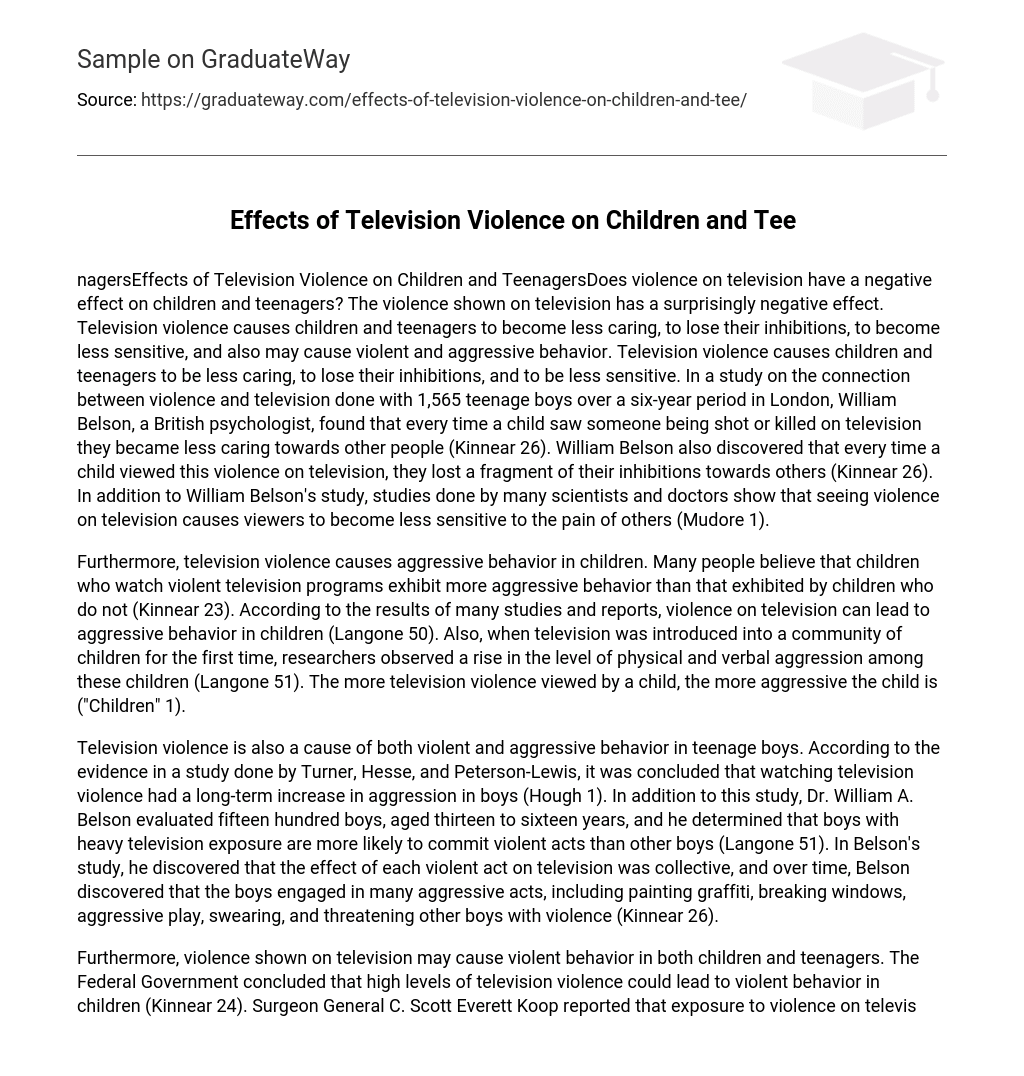The significant adverse impact of television violence on children and teenagers includes decreased empathy, reduced inhibitions, and desensitization. Additionally, it can potentially contribute to the emergence of violent and aggressive behaviors.
In a study conducted in London by British psychologist William Belson, the correlation between television violence and its effect on teenage boys was explored. Over a span of six years, Belson observed 1,565 participants and discovered that being exposed to scenes depicting shooting or death on television resulted in a reduction of empathy towards others (Kinnear 26).
According to William Belson (Kinnear 26) and numerous studies by scientists and doctors, such as Mudore (1), watching violence on television causes children to become less inhibited towards others and leads to reduced sensitivity towards others’ pain.
Many believe that children who watch violent television shows are more likely to display aggressive behavior (Kinnear 23). Numerous studies and reports have consistently found a link between exposure to violence on television and increased aggression in children (Langone 50).
When television was first introduced to a group of children, researchers noted an increase in both physical and verbal aggression among the children (Langone 51). The level of aggression in a child is directly correlated to the amount of television violence they are exposed to (“Children” 1).
Turner, Hesse, and Peterson-Lewis conducted a study that revealed television violence is responsible for promoting violent and aggressive behavior in teenage boys. Their research concluded that boys who watch violent television shows experience a lasting increase in aggression (Hough 1). Dr. William A. Belson’s study evaluated fifteen hundred boys between the ages of thirteen and sixteen, finding that those exposed to high levels of television are more likely to engage in violent acts compared to their peers (Langone 51).
Belson’s study revealed that the cumulative impact of violent acts on television had an influence on the behavior of boys. Over time, Belson observed that the boys exhibited various aggressive behaviors such as graffiti painting, window breaking, aggressive play, swearing, and making threats of violence towards other boys (Kinnear 26).
Moreover, the correlation between violence portrayed on television and its potential influence on violent behavior in children and teenagers has been extensively researched. The Federal Government’s investigation confirmed that a significant amount of television violence could result in aggression among children (Kinnear 24). Surgeon General C. Scott Everett Koop further supported this claim by highlighting that exposure to violence on television plays a role in the development of childhood violence (Langone 49). Additionally, George Comstock, a renowned expert on the impact of violence in both television and film, analyzed several studies and found that the consumption of television violence contributed to an escalation in aggressive tendencies in children (Kinnear 27).
The impact of television violence on children and teenagers includes a decline in empathy, an increase in aggression, decreased inhibitions, and lowered sensitivity. This issue requires urgent attention to be addressed effectively. Parents can play a crucial role in their communities by taking various measures like writing letters to cable companies, starting petitions, and limiting their children’s exposure to violent TV shows.
Works Cited
-
Children and TV Violence. 03 Nov. 2001. The American Academy of Child and Adolescent Psychiatry. O4 Nov. 2001
. - Kinnear, Karen L. Violent Children. Santa Barbara: ABC-CLIO, 1995.
- Langone, John. Violence!: Our fastest growing health problem. Boston: Little, Brown, 1984.
-
Mudore, Constance Faye. “Does TV Violence Kill?” Current Health 2 Feb. 2000. 3 Nov. 2001





